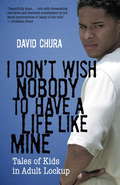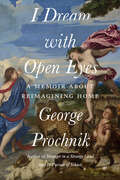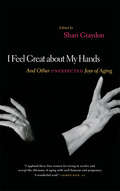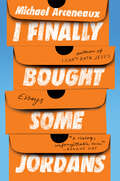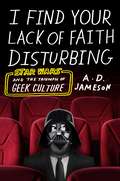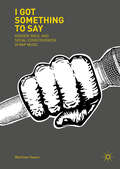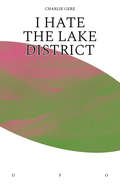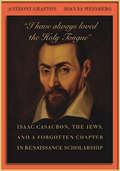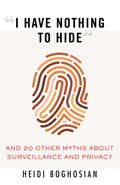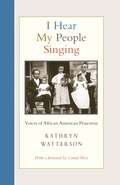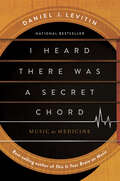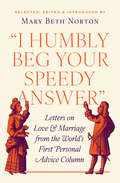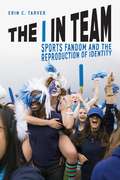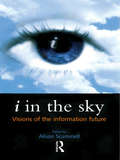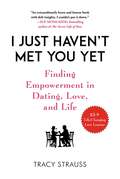- Table View
- List View
I Don't Want To Talk About It: Overcoming the Secret Legacy of Male Depression
by Terrence RealReal provides an informative and easy-to-read explanation of depression as men experience this illness. An integrated presentation. Technical terms are clearly explained.
I Don't Wish Nobody to Have a Life Like Mine
by David ChuraSince the early 1990s, thanks to inflamed rhetoric in the media about "superpredators" and a wave of get-tough-on-crime laws, the number of juveniles in prison has risen by 35 percent, according to the U.S. Department of Justice, and their placement in adult prison has increased by 208 percent, according to a 2007 survey by the Campaign for Youth. Since 1992, every state except Nebraska has passed laws making it easier to prosecute youth under eighteen as adults, and most states have legalized harsher sentences for juveniles. David Chura taught high school in a New York county penitentiary for ten years and saw these young people--and the effects of our laws on them--up close. Here he introduces us to the real kids behind the hysteria: vibrant, animated kids full of humor and passion; kids who were born into families broken up and beaten down by drugs, gang violence, AIDS, poverty, and abuse. He also introduces us to wardens, correctional officers, family members, and doctors, and shows how everyone in this world is a child of disappointment. We meet Wade, who carries a stack of photos of his HIV-positive mother in his pocket to take out and share with pride. Khalil has spent all fifteen years of his life in foster care, group homes, juvenile detention, and mental hospitals, yet has channeled his inner demons into poetry. There's Anna, a hard-nosed one-time teenage drug baroness who serves as a tutor to students and older women alike; Dominic, a father of two who only reads in jail, and only the Harry Potter books; and Eddyberto, a bright student and self-taught artist whose wildly creative drawings are confiscated and used to accuse him of being a potential terrorist and threat to national security. Then there's O'Shay, a big, burly, snarling Bronx-Irish classroom officer with a surprising protective side for the underdog, and Ms. Wharton, a hallway officer with a spiky demeanor but a soft spot for animals. In language that carries both the grit of the street and the expansiveness of poetry, Chura breaks down the divisions we so easily erect between us and them, the keepers and the kept--and shows how, ultimately, we as individuals and as a society have failed these young people.
I Dream with Open Eyes: A Memoir
by George ProchnikA journey of reckoning and renewal, this story of family history and future dreams is an examination of the individual imagination as a catalyst for social changeWhatever the ideological slant of our information feeds, nowadays we all share a sense of binge-watching the apocalypse. Facing so much uncertainty, we need a language for thinking about the unknown not simply as a threat but also as a space of fertile possibility. George Prochnik has chosen to reflect on these urgent themes through the lens of a personal narrative: an account of his own family&’s decision to leave the United States.I Dream with Open Eyes begins with an exploration of Prochnik&’s ancestral past: the pilgrimage of his mother&’s family, who were among the first English settlers in the New World. In the aftermath of the 2016 election, a parallel migration unfolds as Prochnik, along with his wife and their son, makes the decision to uproot their lives in New York to move to England.A deep critique of this current moment, Prochnik takes the words of nineteenth-century poet Heinrich Heine, &“I dream with open eyes, and my eyes see,&” as an inspiration to ask how, as a society, we might use art and literature to refract and expand our vision of the future, while simultaneously generating a new focus on present realities.
I Feel Bad About My Neck: And Other Thoughts On Being A Woman
by Nora Ephron#1 NATIONAL BESTSELLER • A candid, hilarious look at women of a certain age and dealing with the tribulations of maintenance, menopause, empty nests, and life itself.&“Wickedly witty ... Crackling sharp ... Fireworks shoot out [of this collection].&” —The Boston GlobeWith her disarming, intimate, completely accessible voice, and dry sense of humor, Nora Ephron chronicles her life as an obsessed cook, passionate city dweller, and hapless parent. But mostly she speaks frankly and uproariously about life as an older woman. Utterly courageous, uproariously funny, and unexpectedly moving in its truth telling, I Feel Bad About My Neck is a scrumptious, irresistible treat of a book, full of truths, laugh out loud moments that will appeal to readers of all ages.
I Feel Earthquakes More Often Than They Happen
by Amy WilentzFrom one of our most astute contemporary writers, Amy Wilentz, comes an irreverent, inventive portrait of the state of California and its unlikely governor, Arnold Schwarzenegger. The prizewinning author, a lifelong easterner and an outsider in the West, takes the reader on a picaresque journey from exclusive Hollywood soirees to a fantasy city in the Mojave desert, from the La Brea Tar Pits to celebrity-besotted Sacramento, from the tents of Skid Row to surf-drunk Malibu, from a snowbird retreat near Mexico to the hippie preserve of tide-beaten Big Sur, along the way offering up sharp observations on politics, fund-raising, the water supply, the Beach Boys, earthquake preparedness, home economics, catastrophism, movie-star politicians, political movie stars, Charlie Manson, and location scouts who want to rent your house in order to make television commercials for bathroom wall cleansers or Swedish banks. Wilentz moved to Los Angeles from a Manhattan wounded by September 11, only to discover a paradise marred by fire, flood, and mudslides. In what seemed like a joke to her, a Democratic governor nicknamed Gumby was about to be ousted by an Austrian muscleman in a bizarre election promoted by a millionaire whose business was car alarms. Intrigued, she set out to find the essence of the quirky, trailblazing state. During her travels, she spots celebrities but can't quite place them, drops in on famous salons with habitués like Warren Beatty and Arianna Huffington, and visits the neglected office of one very special 9,000-year-old woman. Plunging into the traffic of California, Wilentz noodles out meaning in some of the least likely of places; she sees the political in the personal and the personal in the political. By now an expert on tremors real and imagined, she offers readers on both coasts insights into where California stands today, and America as well.
I Feel Great About My Hands
by Shari GraydonNora Ephron struck a chord with I Feel Bad about My Neck. Women's advocate and acclaimed writer Shari Graydon set out to counter the supposed downhill slide-inspired grief by inviting notable women from across Canada - all over 50 - to provide an alternative perspective.I Feel Great about My Hands is a collection of stories, essays and poems embracing the changes, discoveries and wisdom that come with age. This colourful anthology includes:Gemini award-honoured funnywoman Mary Walsh on playing a "big, loud, opinionated old bag"Celebrated poet Lorna Crozier's hilariously graphic "My Last Erotic Poem"Val Napoleon, an adopted Gitksan member of Cree heritage applying Aboriginal trickster tales to modern attitudes about agingShari Graydon herself focusing her "face-half-unwrinkled" attention on the hands that have helped her nurture life and express creativity and joyRoyalties from the book will benefit Media Action, an organization dedicated to challenging the under-representation and sexualization of women in the media.
I Fight for a Living: Boxing and the Battle for Black Manhood, 1880-1915
by Louis MooreThe black prizefighter labored in one of the few trades where an African American man could win renown: boxing. His prowess in the ring asserted an independence and powerful masculinity rare for black men in a white-dominated society, allowing him to be a man--and thus truly free. Louis Moore draws on the life stories of African American fighters active from 1880 to 1915 to explore working-class black manhood. As he details, boxers bought into American ideas about masculinity and free enterprise to prove their equality while using their bodies to become self-made men. The African American middle class, meanwhile, grappled with an expression of public black maleness they saw related to disreputable leisure rather than respectable labor. Moore shows how each fighter conformed to middle class ideas of masculinity based on his own judgment of what culture would accept. Finally, he argues that African American success in the ring shattered the myth of black inferiority despite media and government efforts to defend white privilege.
I Finally Bought Some Jordans: Essays
by Michael Arceneaux"Very good writers have an ability to make you understand what they're feeling. But the very best writers have an ability to make you understand what you're feeling. And that's where Michael Arceneaux sits, and that's what he does in this new book. It's like he's crawling around inside your head opening file cabinets and telling you what the gibberish you've scribbled on each page in each file means. What a great, fun read."—Shea Serrano, #1 New York Times bestselling authorNew York Times bestselling author Michael Arceneaux returns with a hilarious collection of essays about making your voice heard in an increasingly noisy and chaotic world.In his books I Can't Date Jesus and I Don't Want to Die Poor, Michael Arceneaux established himself as one of the most beloved and entertaining writers of his generation, touching upon such hot-button topics as race, class, sexuality, labor, debt, and, of course, paying homage to the power and wisdom of Beyoncé. In this collection, Arceneaux takes stock of how far he has traveled—and how much ground he still has to cover in this patriarchal, heteronormative society. He explores the opportunities afforded to Black creatives but also the doors that remain shut or ever-so-slightly ajar; the confounding challenges of dating in a time when social media has made everything both more accessible and more unreliable; and the allure of returning home while still pushing yourself to seek opportunity elsewhere.I Finally Bought Some Jordans is both a corrective to, and a balm for, these troubling times, revealing a sharply funny and keen-eyed storyteller working at the height of his craft.
I Find Your Lack of Faith Disturbing: Star Wars and the Triumph of Geek Culture
by A. D. Jameson"Funny, incisive, and timely ... Jameson does for geeks what geek culture does for its superheroes: he takes them seriously, respects their power, and refuses to hide his deep affection." —Lawrence Kasdan, co-screenwriter of The Empire Strikes Back, Return of the Jedi, The Force Awakens, and Solo: A Star Wars StoryIn I Find Your Lack of Faith Disturbing, A. D. Jameson takes geeks and non-geeks alike on a surprising and insightful journey through the science fiction, fantasy, and superhero franchises that now dominate pop culture. Walking us through the rise of geekdom from its underground origins to the top of the box office and bestseller lists, Jameson takes in franchises like The Lord of the Rings, Guardians of the Galaxy, Harry Potter, Star Trek, and, in particular, Star Wars—as well as phenomena like fan fiction, cosplay, and YouTube parodies. Along the way, he blasts through the clichés surrounding geek culture: that its fans are mindless consumers who will embrace all things Spider-Man or Batman, regardless of quality; or that the popularity and financial success of Star Wars led to the death of ambitious filmmaking.A lifelong geek, Jameson shines a new light on beloved classics, explaining the enormous love (and hate) they are capable of inspiring in fan and non-fan alike, while exploding misconceptions as to how and why they were made. I Find Your Lack of Faith Disturbing tells the story of how the geeks have inherited the earth.
I Go to America: Swedish American Women and the Life of Mina Anderson
by Joy K. LintelmanNear the end of her life, Mina Anderson penned a lively memoir that helped Swedish novelist Vilhelm Moberg create "Kristina", the central female character of his beloved emigrant novels, a woman who constantly yearns for her homeland. But Mina's story was quite different. Showcasing her previously untranslated memoir, "I Go To America" traces Mina's trip across the Atlantic to Wisconsin and then the Twin Cities, where she worked as a domestic servant, and her move to rural Mille Lacs County, where she and her husband worked a farm, raised seven children, and contributed to rural Swedish community life. Mina herself writes about how grateful she was for the opportunity to be in America, where the pay was better, class differences were unconfining, and children -- girls included -- had the chance for a good education. In her own words, "I have never regretted that I left Sweden. I have had it better here". Joy Lintelman greatly expands upon Mina's memoir, detailing the social, cultural, and economic realities experienced by countless Swedish women of her station. Lintelman offers readers both an intimate portrait of Mina Anderson and a window into the lives of the nearly 250,000 young, single Swedish women who immigrated to America from 1881 to 1920 and whose courage, hard work, and pragmatism embody the American dream.
I Got Something to Say: Gender, Race, and Social Consciousness in Rap Music
by Matthew OwareWhat do millennial rappers in the United States say in their music? This timely and compelling book answers this question by decoding the lyrics of over 700 songs from contemporary rap artists. Using innovative research techniques, Matthew Oware reveals how emcees perpetuate and challenge gendered and racialized constructions of masculinity, femininity, and sexuality. Male and female artists litter their rhymes with misogynistic and violent imagery. However, men also express a full range of emotions, from arrogance to vulnerability, conveying a more complex manhood than previously acknowledged. Women emphatically state their desires while embracing a more feminist approach. Even LGBTQ artists stake their claim and express their sexuality without fear. Finally, in the age of Black Lives Matter and the presidency of Donald J. Trump, emcees forcefully politicize their music. Although complicated and contradictory in many ways, rap remains a powerful medium for social commentary.
I Had to Say Something: The Art of Ted Haggard's Fall
by Mike Jones Sam GallegosThis is the story of the sexual relationship between Michael Forest Jones, a Denver man who worked as an escort, and the Reverend Ted Haggard, founder and pastor of the New Life Church of Colorado Springs.As a rule, Mike never delved into the personal lives of his clients. He entertained celebrities, clergyman, politicians, pro-football players, and just regular guys. In 2003, a man named "Art" called Mike to set up an appointment. For almost three years, Art came to see him at least once a month. It was simply a business relationship for Mike, yet he sensed that for Art, it was more. Like many clients who were closeted, Art revealed his vulnerabilities as he struggled to deny his true desire for sexual contact and affection with a man.One day, while working out at his gym, Mike recognized "Art" preaching hate on a religious cable channel. He soon discovered that Art was actually the Reverend Ted Haggard, who, as President of the National Association of Evangelicals, influenced the daily lives of millions of believers, condemning homosexuality and advocating virulently against gay rights and same-sex unions. On November 1, 2006, Mike made public his relationship with Ted Haggard. Within days, Haggard resigned from all his positions of power, admitting to a "sexual immorality" that shook the evangelical world, right before Election Day 2006. Once Haggard was outed, Mike's clients stopped calling. He had effectively put himself out of business and put himself at risk of being trivialized and dismissed, as sex workers often are. It was Mike's courage and strength of conscience that ultimately led him to come forward about the hypocrisy of Haggard's life. Here is the disarming story of how one man's deceit inspired another man to become a spokesperson for telling the truth and for not being ashamed of who you are.
I Hate the Lake District (Goldsmiths Press / Unidentified Fictional Objects)
by Charlie GereAn alternative view of the North West of England that delves into its stranger past. I Hate the Lake District offers a different vision of the rural environment from those found in much contemporary nature writing. Based on the author's trips around North West England, the book engages with nuclear power and nuclear war, slavery, imperialism, ghosts, love, God, cockroaches, and the sheer violence and contingency of “nature” itself—of which the human presence is merely a part. Each chapter starts with an account of a visit to a place in this remote part of England, the deep north, but digresses and wanders through multifarious themes and subjects. Among the sites Gere visits are the defunct nuclear power station at Sellafield, home of all British nuclear waste; Lake Coniston, where Donald Campbell died trying to break the water speed record; Hadrian's Wall, furthermost reach of the Roman Empire; the mysterious and deathly Morecambe Bay; sites of slavery in the North West; places where UFOs have been sighted, avant-garde artists created work, and Islamic terrorists trained; shantytowns where the navvies who built the railways lived with their families; and even the remains of Blobbyland in Morecambe. In I Hate the Lake District, Gere challenges the bourgeois pastoralism of popular nature writing and reveals the landscape of North West England as profoundly unnatural and strange.
I have always loved the Holy Tongue: Isaac Casaubon, the Jews, and a Forgotten Chapter in Renaissance Scholarship
by Anthony Grafton Joanna WeinbergIsaac Casaubon (1559-1614) was one of Europe’s greatest Protestant scholars during the late Renaissance and was renowned for his expert knowledge of the early history of the church. Today, however, most of Casaubon’s books remain unread, and much of his vast archive remains unexplored. Grafton and Weinberg’s close examination of his papers reveal for the first time that Casaubon’s scholarship was broader and richer than anyone has previously suspected, and they present a Casaubon not found in earlier literature: one who used Jewish materials to illuminate, and at times to transform, scholars’ understanding of of early Christianity; and one who, at the end of his life, worked with a little-known Jewish scholar in order to master parts of the Talmud, which few Christians could study on their own. Most importantly , this book shows that a Christian scholar of the European Renaissance could explore—and develop striking sympathy and affection for—the alien world and worship of the Jews.
“I Have Nothing to Hide”: And 20 Other Myths About Surveillance and Privacy
by Heidi BoghosianAn accessible guide that breaks down the complex issues around mass surveillance and data privacy and explores the negative consequences it can have on individual citizens and their communities.No one is exempt from data mining: by owning a smartphone, or using social media or a credit card, we hand over private data to corporations and the government. We need to understand how surveillance and data collection operates in order to regain control over our digital freedoms—and our lives.Attorney and data privacy expert Heidi Boghosian unpacks widespread myths around the seemingly innocuous nature of surveillance, sets the record straight about what government agencies and corporations do with our personal data, and offers solutions to take back our information. &“I Have Nothing to Hide&” is both a necessary mass surveillance overview and a reference book. It addresses the misconceptions around tradeoffs between privacy and security, citizen spying, and the ability to design products with privacy protections. Boghosian breaks down misinformation surrounding 21 core myths about data privacy, including:● &“Surveillance makes the nation safer.&”● &“No one wants to spy on kids.&”● &“Police don&’t monitor social media.&”● &“Metadata doesn&’t reveal much about me.&”● &“Congress and the courts protect us from surveillance.&”● &“There&’s nothing I can do to stop surveillance.&”By dispelling myths related to surveillance, this book helps readers better understand what data is being collected, who is gathering it, how they&’re doing it, and why it matters.
"I Hear America Singing": Folk Music and National Identity
by Rachel Clare DonaldsonFolk music is more than an idealized reminder of a simper past. It reveals a great deal about present-day understandings of community and belonging. It celebrates the shared traditions that define a group or nation. In America, folk music--from African American spirituals to English ballads and protest songs--renders the imagined community more tangible and comprises a critical component of our diverse national heritage. In "I Hear America Singing," Rachel Donaldson traces the vibrant history of the twentieth-century folk music revival from its origins in the 1930s through its end in the late 1960s. She investigates the relationship between the revival and concepts of nationalism, showing how key figures in the revival--including Pete Seeger , Alan Lomax, Moses Asch, and Ralph Rinzler--used songs to influence the ways in which Americans understood the values, the culture, and the people of their own nation. As Donaldson chronicles how cultural norms were shaped over the course of the mid-twentieth century, she underscores how various groups within the revival and their views shifted over time. "I Hear America Singing" provides a stirring account of how and why the revivalists sustained their culturally pluralist and politically democratic Americanism over this tumultuous period in American history.
I Hear My People Singing: Voices of African American Princeton
by Kathryn WattersonA vivid history of life in Princeton, New Jersey, told through the voices of its African American residentsI Hear My People Singing shines a light on a small but historic black neighborhood at the heart of one of the most elite and world-renowned Ivy-League towns—Princeton, New Jersey. The vivid first-person accounts of more than fifty black residents detail aspects of their lives throughout the twentieth century. Their stories show that the roots of Princeton’s African American community are as deeply intertwined with the town and university as they are with the history of the United States, the legacies of slavery, and the nation’s current conversations on race.Drawn from an oral history collaboration with residents of the Witherspoon-Jackson neighborhood, Princeton undergraduates, and their professor, Kathryn Watterson, neighbors speak candidly about Jim Crow segregation, the consequences of school integration, World Wars I and II, and the struggles for equal opportunities and civil rights. Despite three centuries of legal and economic obstacles, African American residents have created a flourishing, ethical, and humane neighborhood in which to raise their children, care for the sick and elderly, worship, stand their ground, and celebrate life. Abundantly filled with photographs, I Hear My People Singing personalizes the injustices faced by generations of black Princetonians—including the famed Paul Robeson—and highlights the community’s remarkable achievements. The introductions to each chapter provide historical context, as does the book’s foreword by noted scholar, theologian, and activist Cornel West.An intimate testament of the black community’s resilience and ingenuity, I Hear My People Singing adds a never-before-compiled account of poignant black experience to an American narrative that needs to be heard now more than ever.
I Heard It Through the Grapevine: Rumor in African-American Culture
by Patricia A. TurnerI Heard It Through the Grapevine explores how rumors that run rife in African-American communities, concerning such issues as AIDS, the Ku Klux Klan and FBI conspiracies, translate white oppression into folk warnings, and are used by the community to respond to a hostile dominant culture.
I Heard There Was A Secret Chord: Music as Medicine
by Daniel J. LevitinNeuroscientist and New York Times bestselling author of This Is Your Brain on Music Daniel J. Levitin reveals how the deep connections between music and the human brain can be harnessed for healing.Music is perhaps one of humanity&’s oldest medicines as well as its most universal: from China to the Ottoman Empire, Europe to Africa and pre-colonial South America, cultures have developed rich traditions for using sound and rhythm to ease suffering, spur healing, and calm the mind. Despite this history, musical therapy has long been considered the remit of ancient practice and alternative medicine, if not outright quackery and pseudoscience. In the last decade, however, an overwhelming body of scientific evidence has emerged that persuasively argues music can offer profoundly effective treatment for a whole host of ailments, from Alzheimer&’s to PTSD, depression, pain, and cognitive injury. It is, in short, one of the most potent and remarkably promising new therapies available today.A work of dazzling ideas, cutting-edge research, and joyful celebration of the human mind, I Heard There Was a Secret Chord explores the critical role music has played in human evolution, illuminating how the story of the human brain is inseparable from the creative enterprise of music that has bound cultures together throughout history. Music insinuates itself into our earliest memories; it is intimately connected to our emotional regulation and cognition; its shared rhythms and sounds are essential to our social behaviors. As neuroscientist Daniel J. Levitin demonstrates in this mind-expanding follow-up to This Is Your Brain on Music—which revolutionized our understanding of the neuroscience of song—medical researchers are now finding that these same deep connections can be harnessed to create profound benefits for those both young and old.
I Heard There Was A Secret Chord: Music as Medicine
by Daniel J. LevitinNeuroscientist and New York Times bestselling author of This Is Your Brain on Music Daniel J. Levitin reveals how the deep connections between music and the human brain can be harnessed for healing.Music is perhaps one of humanity&’s oldest medicines as well as its most universal: from China to the Ottoman Empire, Europe to Africa and pre-colonial South America, cultures have developed rich traditions for using sound and rhythm to ease suffering, spur healing, and calm the mind. Despite this history, musical therapy has long been considered the remit of ancient practice and alternative medicine, if not outright quackery and pseudoscience. In the last decade, however, an overwhelming body of scientific evidence has emerged that persuasively argues music can offer profoundly effective treatment for a whole host of ailments, from Alzheimer&’s to PTSD, depression, pain, and cognitive injury. It is, in short, one of the most potent and remarkably promising new therapies available today.A work of dazzling ideas, cutting-edge research, and joyful celebration of the human mind, I Heard There Was a Secret Chord explores the critical role music has played in human evolution, illuminating how the story of the human brain is inseparable from the creative enterprise of music that has bound cultures together throughout history. Music insinuates itself into our earliest memories; it is intimately connected to our emotional regulation and cognition; its shared rhythms and sounds are essential to our social behaviors. As neuroscientist Daniel J. Levitin demonstrates in this mind-expanding follow-up to This Is Your Brain on Music—which revolutionized our understanding of the neuroscience of song—medical researchers are now finding that these same deep connections can be harnessed to create profound benefits for those both young and old.
"I Humbly Beg Your Speedy Answer": Letters on Love and Marriage from the World’s First Personal Advice Column
by Mary Beth NortonA fascinating collection of questions and answers—about courtship, marriage, love, and sex—from a seventeenth-century periodical The Athenian Mercury—a one-page, two-sided periodical published in 1690s London—included the world&’s first personal advice column. Acclaimed historian and Pulitzer Prize–finalist Mary Beth Norton&’s &“I Humbly Beg Your Speedy Answer&” is a remarkable collection of questions and answers drawn from this groundbreaking publication.In these exchanges, anonymous readers look for help with their most intimate romantic problems—about courting, picking a spouse, getting married, securing or avoiding parental consent, engaging in premarital sex and extramarital affairs, and much more. Spouses ask how to handle contentious marriages and tense relationships with in-laws. Some correspondents seek ways to ease a conscience troubled by romantic and sexual misbehavior. The lonely wonder how to meet a potential partner—or how to spark a warmer relationship with someone they already have an eye on. And both men and women inquire about how to extract themselves from relationships turned sour. Many of these concerns will be familiar to readers of today&’s advice columns. But others are delightfully strange and surprising, reflecting forgotten social and romantic customs and using charmingly unfamiliar language in which, for example, &“kissing is a luscious diet,&” a marriage might provide &“much love and moderate conveniency,&” and an &“amorous disposition&” can lead to trouble.Delightful and entertaining, &“I Humbly Beg Your Speedy Answer&” provides a unique, intriguing, and revealing picture of what has—and hasn&’t—changed over the past three centuries when it comes to love, sex, and relationships.
The I in Team: Sports Fandom and the Reproduction of Identity
by Erin C. TarverThere is one sound that will always be loudest in sports. It isn’t the squeak of sneakers or the crunch of helmets; it isn’t the grunts or even the stadium music. It’s the deafening roar of sports fans. For those few among us on the outside, sports fandom—with its war paint and pennants, its pricey cable TV packages and esoteric stats reeled off like code—looks highly irrational, entertainment gone overboard. But as Erin C. Tarver demonstrates in this book, sports fandom has become extraordinarily important to our psyche, a matter of the very essence of who we are. Why in the world, Tarver asks, would anyone care about how well a total stranger can throw a ball, or hit one with a bat, or toss one through a hoop? Because such activities and the massive public events that surround them form some of the most meaningful ritual identity practices we have today. They are a primary way we—as individuals and a collective—decide both who we are who we are not. And as such, they are also one of the key ways that various social structures—such as race and gender hierarchies—are sustained, lending a dark side to the joys of being a sports fan. Drawing on everything from philosophy to sociology to sports history, she offers a profound exploration of the significance of sports in contemporary life, showing us just how high the stakes of the game are.
i in the Sky: Visions of the Information Future
by Alison Scammelli in the Sky is a collection of essays by more than 40 experts, including such leading writers as Charles Handy, Don Tapscott, and Kevin Warwick, giving their personal vision of the future of information. Information here is given its widest meaning and includes such subjects as the Internet, electronic commerce, cybernetics, robotics, artificial intelligence, and even computers as fashion accessories. Information as phenomenon pervades all areas of life, and its evolution has consequences for everyone. Many of the essays have as their central themes the future of computer intelligence; library and information services; interactive Internet marketing; networked learning in higher education; the linking of technology enabling remote and online communication to the deconstruction of the modern corporation; artificial intelligence; scholarly communication; smart houses; intelligent appliances; etc.
I Just Haven't Met You Yet: Finding Empowerment in Dating, Love, and Life
by Tracy StraussA Modern-Day Bridget Jones’s Diary Meets Eat, Pray, Love, One of Bustle’s “Writers to Watch” Offers Advice, Life Lessons, and Lots of HeartI Just Haven’t Met You Yet details Tracy Strauss’s dating history and her journey to dismantle the effects and stigmas of an abusive past, break free of destructive relationship patterns, and ultimately conquer her fear of truly being seen by the world, flaws and all. The author shares the transformative lessons she learned and self-empowerment she achieved while passing each hurdle along the way to finding the love of her life. Tracy Strauss helps readers empower themselves by taking a challenging look at the ways the negative events of their lives, including sexual harassment and abuse, have shaped their self-perception and created obstacles to personal success, and how readers can change that troubled self-image along with their (love) lives. I Just Haven’t Met You Yet is a modern-day journey of the heart. It is a story about taking big risks, changing old habits and beliefs about dating, and speaking back to the naysayers, especially that internal critic, the inner love saboteur. It is a prime mover and the only epistolary memoir cum dating/relationship essay book of its kind.

